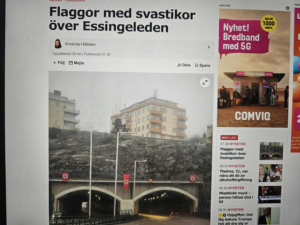
Written by Signal/ Researching and Confronting the Far Right
The Greek election results are naturally multifaceted and open to various interpretations. We witnessed an overt defeat of Syriza and MeRA25, thereby of a large part of the Left. We also saw a big victory for conservative New Democracy. After 4 years of a turbulent administration marked by multiple crises and strong criticism from within and outside of the country’s borders, the party increased its share as well as its number of votes. This major dominance cannot only be explained as a failure of the opposition.
The urgent question is whether we have a new contingent power struggle between parties or whether this constitutes the sign of an ideological shift.
Both are true. The long, gradual conservatisation of the previous years and the drift towards reactionary positions was further aggravated by accelerating factors pertaining to party dynamics and weaknesses, that is, with more transient party correlations, mirrored in the political advantage of New Democracy over a Syriza that lagged far behind.
In the context of this rightward shift, the Far Right has certainly been legitimized, normalized. The Far-Right agenda on issues of law and order, migration, national identity, gender equality and education is certainly easier to unfold in such a friendly environment. Let us not forget that the Right and Far-Right agenda largely overlap on these issues. The two spaces do not collide; they are in osmosis and communication. It is what we call the Hinterland of the Alt-Right.
The relationship between the Right and the Far Right
As concerns the Far Right, it is definitely still going strong. It spans a broad constellation of formations and persons, and continues to seek a central party expression. The call for the “unity of patriotic, national forces” is repeated but not realised, possibly due to the personal ambition or idiosyncratic particularities of some of its leaders.
New Democracy has incorporated aspects of the Far-Right agenda and Alt-Right rhetoric, and seems to be absorbing a part of the Far-Right vote, without this leading to a weakening of the pure Far-Right space. This may be explained by the expansion of the audience of this rhetoric.
Of course, it is extremely positive that there doesn’t seem to be a violent expression of this space at the moment, as Golden Dawn with its assault squads used to be. The capacity of the Far Right, however, remains unwavering and fluctuates between 8 and 10%.
The vote of Golden Dawn and neo-Nazi convict Kasidiaris
In the run-up to the election, the question was where two large groups of Far-Right voters would veer towards: Golden Dawn voters (2.93% or 165,620 ballots in 2019) and the high, according to the polls, share gathered by the formation Ellines (Greeks) of Ilias Kasidiaris (up to 6% according to certain polls), who was barred from participating in the election by the Supreme Court.
Kasidiaris who, after certain media stunts, seemed he would probably support the EAN party led by former Supreme Court judge Anastasios Kanellopoulos, in the end didn’t issue a clear line to his supporters – which was reflected in the final result. The Far Right-allied media speculate that, to a high degree, his followers either didn’t vote or are just waiting for the next election.
According to an analysis by MARC pollsters, the Golden Dawn vote was scattered. Greek Solution appeared to benefit the most, taking 24.5%. Right behind it was New Democracy with 18%, Plefsi Eleftherias (Course for Freedom) with 8.7%, Syriza with 5.8% and Pasok with 5.4%. This shows an anticipated dispersion, with larger density toward the right and an important thinning out towards the left of the spectrum. Plefsi Eleftherias expresses many characteristics and positions that prevent it from being classified as left while Far-Right voters would be familiar to certain core elements of its platform.
Greek Solution and Niki: the “soft” Far Right
After the “weeding out” of parties by the Supreme Court, Greek Solution emerged as a leader of the Far Right. It possesses many qualities reminiscent of Giorgos Karatzaferis’ LAOS (Popular Orthodox Rally): conspiracism, an exaggerated televised presence and a constant stirring the pot, exploiting fear, ignorance and xenophobia.
Niki is one of the surprises of the May 21 election. The party of nationalist teacher Dimitris Natsios was founded in 2019. It performed a low-level flight that went under most of our radars up until a few days before the election, polling a 1–1.5% share. It appears to have numerous, and dubious, resources. It campaigned as a “party against parties”, rejected the Left/Right divide and vied for a share of the vote from the reservoir of anti-vaxxers and quasi-religious groups. In an effort to avoid being labelled as a group of the Far-Right space, Niki promotes itself as a “democratic patriotic movement”, while expressing the main qualities of the formations of this space (nationalism, anti-migration racism, welfare chauvinism, strong state) along with irrational and traditionalist patriarchal elements.
Comparative performance of the Far Right
In this year’s election, 11 of the 17 Far-Right parties that submitted a request to the Supreme Court participated in the election. Most are newly founded parties, with a strong representation in northern Greece.
There was thus a proliferation of Far-Right parties participating in the election as in 2019 only four Far-Right parties ran: Greek Solution, which entered Parliament for the first time, Recreate Greece (led by Thanos Tzimeros), Assembly of Greeks of Artemis Sorras and Golden Dawn, which fell short of the parliamentary threshold by 0.07 percentage points.
The total share of the Far-Right vote is 2.5 percentage points higher than in 2019. We have seen a fragmentation of the vote; Greek Solution, however, increased its share as well as its parliamentary representation, while the newly founded Niki missed the parliamentary threshold by 0.08 points and thus enters the June 25 election race in a more advantageous position.
What is also interesting is the geographical distribution of the Far-Right vote. In general, where the Golden Dawn vote was high in 2019, Greek Solution increased its share and Niki also did well (in the constituencies of Halkidiki, Kilkis, Attica II–West, Thessaloniki I, Imathia, Magnesia).
In particular, Greek Solution scored its highest shares in Evros (8.72%) and in Thessaloniki (8.35 and 7.93%) as well as in other northern Greece constituencies (Kilkis, Serres, Imathia), but also in Samos. Its lowest share was in Lefkada.
Niki scored its highest shares in Aitoloakarnania, Drama and Evrytania, and its lowest in Preveza, the Ionian Islands and Crete.
Taking a look at the performance of the third formation in line, National Creation (which did best in Thessaloniki, Halkidiki and Kastoria), it is evident that the bulwarks of the Far Right persist in northern Greece.








